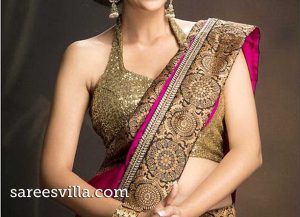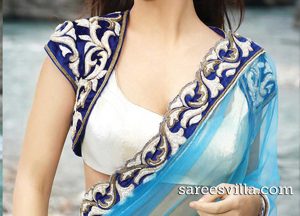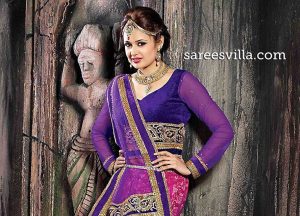Saree Blouses












Indian women have been wearing blouses for centuries. Worn on the upper part of the body as an accompaniment to the saree that covers the body from the neck to the belly button, the saree blouse has indeed come a long way and has travelled down the ages with a variety of rulers including the Mughals and British. Saree blouses in India have been flexible enough to adapt to the changing cultural environment and even today, the humble blouse is worn differently by women from different social strata and are happily accepted in their many styles, cuts and designs.
Origin and History
Worn as an accompaniment to sari/sarees, they find first reference in the Indus Valley Civilization, which prospered from 2800 B.C. to 1800 B.C. in the western part of India. The next reference to the saree blouse was when it was known as ‘stanapatta’, and was just a band of cloth tied around the bust. At this time, India was under the influence of several kings and Maharajas, each influencing the culture and dress of this sub-continent. In the 3rd century B.C., the Chola dynasty rose to power in South India and continued to flourish till the 13th century A.D. In these centuries of power and rule, the saree blouse or the bodice came to be known as the ‘choli.’ In fact, in the 10th century literary work, Rajatarangini or River of Kings, written by Kalhana, there is a reference to the choli from South India that was introduced in Kashmir under its ruler’s order. At this time, the blouse was worn to cover the chest of a woman wearing a saree while the back was entirely bare and covered with the sari pallav. After the Mughals invaded India in the 16th century and later under British rule, cholis underwent further evolution and were worn as stitched pieces of clothing along with sarees. In modern-day Kerala, blouses were not worn with sarees but the upper body was kept bare with just a bust piece covering the area.
Contemporary Saree Blouses
Over the years, the blouse has undergone wide-ranging changes in its styles, cuts, sleeves, necklines and back designs. The blouse today is worn depending on one’s taste and figure but is varied. Overall, it could have long or short sleeves or none at all, and its length could vary from being very short to fitting at the waist. The color of the blouse may either match the color of the sari or be a contrasting color.
Neckline and Back Styles
The beauty of the saree blouse lies in the cut and style of its neckline and back, so it’s not surprising that designers are always experimenting with different cuts, styles and embellishments. Any tailor or designer will give you loads of neck and back patterns to choose from, such as deep U-necks, halter neck, backless choli, boat neck, bow back and off-the-shoulder. It is for this reason, of late, designer saree blouses have become widely popular. It is no surprise to say that there are hundreds of good designs that are being introduced daily in the market.
Types of Indian Saree Blouse Styles Today:
Indian saree blouses are customized to suit each person, though ready-made blouses are also available in different materials, designs, colors and patterns. In a country like India known for its diversity, women of all backgrounds and ages wear different kinds of blouses with sarees. Here are some of the most popular one’s among them:
- Traditional Ladies’ Blouse: For women from traditional backgrounds, this blouse design works best. It’s also good for middle-aged and older women. This blouse has a front opening all the way down with hooks to hold it in place. How deep the neckline and the back should be should be are based on individual tastes. Whether a deep cut is chosen or a modest cut, it’s always a U-cut with cap sleeves.
- Long-Sleeved Blouse: Long-sleeved blouses are usually made out of transparent material like lace with self-designs that add grace and elegance to the wearer’s overall look.
- Sleeveless Blouse: For casual or regular wear, sleeveless blouses are normally worn with sarees. On women with good figures, they look good when teamed up with chiffon sarees. In the summer, this proves to be very practical wear as it gives a lot of comfort from the heat. They are worn with a variety of neck cuts.
- Air Hostess Blouse: This design of blouses are a favorite among women who want to look elegant. Here, the back is covered but the front is fully opened and is held in place with hooks and eyes. The neck design is a U-shape. This design is mainly worn by air hostesses, thus the name.
- Bollywood Blouse: When you’re glamming up for a party or wedding, you can’t possibly wear a normal blouse with your party wear. So, Bollywood style blouses are usually what women choose to wear. These could be either a strapless, backless, noodle strap or string blouse, with a single, double or full string at the back.
- Cami Blouse: This blouse style now has a very bold look, so if you wear this one, you’re sure to get a lot of compliments.
- Noodle Strap Blouse: Here, as the name suggests, you don’t wear sleeves but straps that hold up the blouse over your shoulder. It is usually teamed up with a hipster sari or low-waist jeans on women with amazing figures. These blouses are usually worn to parties, and by film stars and the rich and glamorous.
- Strapless Blouse: Worn by models and fashionable women, these saree blouses do not have sleeves, neck lines or backs. It is similar to a tank top which can be hooked at the back or zipped. It is usually the same color as the saree or taken from it. However, wearers of this kind of blouse prefer to wear the stretchable type that can fit the body snugly.
- Backless Blouse: Though bold and daring, this blouse is given a traditional touch by adding sequins, zari or gota work to it. It is padded heavily from the inside so that a bra is not required and it gives the necessary comfort.
- Big Bow Back: To add a little mischief to a woman’s get up, a big bow at the back of the blouse is perfect. Ideally, in red, black, beige or white, it’s usually meant for an evening out. It looks great when teamed up with a chiffon saree.
Fabrics For Indian Saree Blouses
Saree blouses are made in a variety of materials, such as cotton, Rubia cotton, pure silk, pure crepe, georgette, chiffon, net and Chikan. Whatever the blouse style may be, the Indian saree blouse is an inevitable part of an Indian woman’s wardrobe. Whether she wears it to work, temple or social events, the blouse style may change but the individual style that only a saree draws out will never be seen in any other dress.

